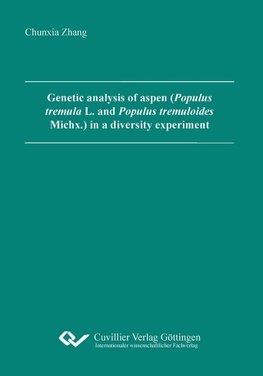
-
 Anglický jazyk
Anglický jazyk
Genetic analysis of aspen (Populus tremula L. and Populus tremuloides Michx.) in a diversity experiment
Autor: Chunxia Zhang
Poplars are model tree species in ecological and genetic studies since they are widely distributed, easy to propagate, and since more genetic and genomic resources are available for poplars than for any other woody plant genus. The poplar diversity experiment... Viac o knihe
Na objednávku, dodanie 2-4 týždne
18.63 €
bežná cena: 20.70 €
O knihe
Poplars are model tree species in ecological and genetic studies since they are widely distributed, easy to propagate, and since more genetic and genomic resources are available for poplars than for any other woody plant genus. The poplar diversity experiment (POPDIV) has been established with European and North American aspen (Populus tremula L., P. tremuloides Michx.) planted in plots representing either a single deme only or combinations of two, four and eight demes in order to test the influence of intraspecific genetic diversity on ecosystem functions and services. In the present study, the most commonly used molecular markers, SSRs (simple sequence repeats) and AFLPs (amplified fragment length polymorphisms), were applied to conduct the genetic analysis of the POPDIV experiment. Both markers identified clonal structures in one Swedish deme and these clones are non-randomly distributed in the POPDIV experimental field. Large differences with regard to the genetic diversity within aspen demes were observed. The genetic diversity estimates based on SSR and AFLP markers showed a high correlation. The North American P. tremuloides deme had the highest level of genetic diversity; most private alleles both at SSRs and AFLPs were also observed in this deme which confirmed that it represents another species different from the European P. tremula. An analysis of molecular variance (AMOVA) revealed that most of the total genetic diversity was found within demes by both SSR and AFLP markers, but the genetic differentiation among demes was also high. Pairwise FST values between demes showed highly significant differentiation at both SSRs and AFLPs. As expected, the P. tremuloides deme was strongly differentiated from the other P. tremula demes. UPGMA dendrograms based on genetic distances obtained from both markers showed that the North American P. tremuloides deme is obviously outgrouped from the other European P. tremula demes with high bootstrap support values. The complex patterns of genetic diversity and differentiation resulted in large differences of the genetic variation within plots. Genetic diversities within plots with a given number of demes were highly variable. Across all plots, those with a single German deme and those with two demes showed the lowest and highest level of genetic diversity, respectively. The plots containing the North American P. tremuloides deme showed higher levels of genetic diversity compared to the plots including only P. tremula demes, which was obviously shown at AFLPs. For the plots with a given number of demes (1, 2, 4, 8), their average genetic diversity values were increased with increasing number of demes included within plots. However, the genetic variation within plots strongly depended on the specific mixture, and the highest diversities were observed for plots with only two demes mixed. Paternity analysis revealed different numbers of paternal trees contributed to both German single tree progenies, the deme with a high number of pollen donors showed high level of genetic diversity. The sibship reconstruction revealed a higher number of full sibling groups for the North American P. tremuloides deme compared to other demes. Across demes, the genetic diversity revealed by AFLP markers showed a positive correlation with the number of full sibling groups, indicating that the number of full sibling groups reflects the effective number of population size which directly determines the level of genetic diversity. In conclusion, the high and variable levels of genetic diversity observed within all demes need to be considered in assessments of the impact of intraspecific diversity of poplars on the diversity of the associated organisms and ecosystem functions and services. The genetic diversity in a plot strongly depends on the specific combination of demes; the number of demes included within a plot is a poor predictor of its diversity.
- Vydavateľstvo: Cuvillier
- Rok vydania: 2012
- Formát: Paperback
- Rozmer: 210 x 148 mm
- Jazyk: Anglický jazyk
- ISBN: 9783954042043

 Nemecký jazyk
Nemecký jazyk 





